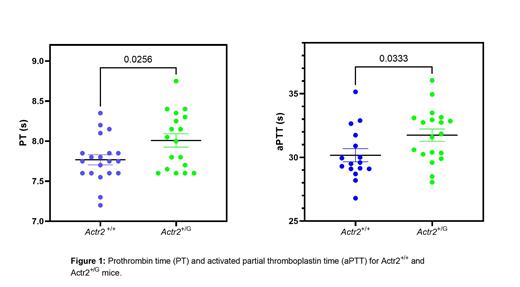Introduction: Venous thromboembolism (VTE) displays significant heritability, yet the genes explaining this heritability are not completely characterized. We previously identified that tissue factor pathway inhibitor heterozygosity ( Tfpi+/−) on the homozygous F5L background ( F5L/L) produces a lethal perinatal thrombotic phenotype. Using a sensitized ENU mutagenesis screen, we discovered an autosomal dominant missense mutation in the Actr2 gene (p.R258G, Actr2G) that suppresses thrombosis and restores survival to F5L/LTfpi+/− mice. Inheritance of the Actr2Gmutation is associated with nearly complete suppression of the lethal F5L/LTfpi+/- phenotype. Actr2 codes for the ARP2 protein, an essential component of the ARP2/3 complex, which mediates actin cytoskeletal rearrangements during platelet activation. We hypothesized that the Actr2G variant affects blood coagulation and platelet function to reduce thrombosis.
Methods: To investigate potential effects of the Actr2G mutation on the coagulation cascade, prothrombin time (PT), activated partial thromboplastin time (aPTT), and plasma-dependent thrombin generation assays (TGA) were used to evaluate clot formation. A mouse tail clip assay was used to measure bleeding time and quantify blood loss. Finally, platelets were assessed for functional defects using platelet spreading and aggregometry assays.
Results:Actr2+/Gplasma had significantly prolonged PT and aPTT compared to wild type controls (N>17, p<0.03). There was also a significant reduction in Actr2+/G thrombin peak height compared to wildtypes (N=10; p=0.03). Despite the delayed time to clot formation, Actr2+/G mice did not exhibit a bleeding phenotype and showed no significant differences in blood loss from tail clip assays. Activated Actr2+/G platelets exhibited reduced surface area and adhesion (N=5; p<0.02), as well as significant defects in collagen induced whole blood aggregation (N=10; p<0.02).
Discussion: The results of the PT, aPTT and TGA indicate reduced thrombin generation potential, suggesting a defect in the common pathway of coagulation. This hypocoaguability may be due to a decrease in circulating procoagulant factors, or an increase in endogenous thrombin inhibitors. Both the significantly decreased aggregation and defective platelet spreading in the Actr2+/G mice indicate that Actr2+/G platelets are less responsive to agonists, a protective mechanism that contributes to overall thrombosis suppression.
Conclusion: In summary, our studies demonstrate the pleiotropic effects that the Actr2G mutation exerts in suppressing thrombosis. The combination of altered plasma coagulation and platelet reactivity likely contribute to suppression of the F5L/LTfpi+/− phenotype. Defects in these actin-mediated processes precipitated by Actr2+/G are the likely root of the F5L/LTfpi+/- phenotype rescue, demonstrating the power of this gene in maintaining hemostatic balance. However, the combination of these thrombosis suppressing phenotypes is not significant enough to prolong the bleeding time in mice with the Actr2G mutation. Thus, our results suggest that targeting actin proteins such as ARP2 for novel antithrombotic drug therapies may have clinical applicability with limited effects on bleeding.
Disclosures
No relevant conflicts of interest to declare.


This feature is available to Subscribers Only
Sign In or Create an Account Close Modal